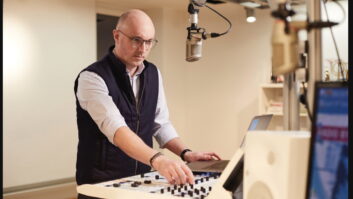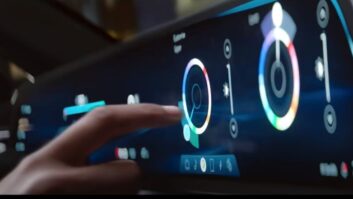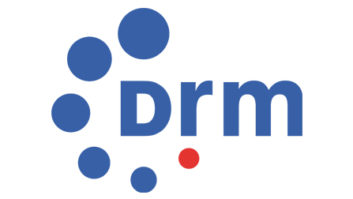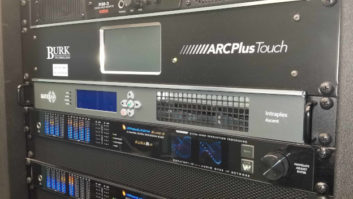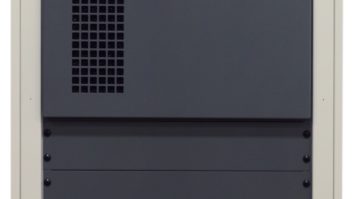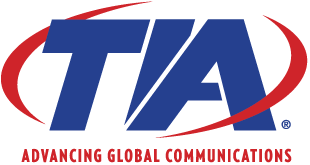A radio receiver consisting of just a very good analog-to-digital converter connected directly to the antenna plus a powerful computer could make a great radio. However, the present state of the technology does not allow this: The available analog-to-digital converters are either not fast enough to handle the entire FM spectrum of, say, 110 MHz, or they don’t have enough dynamic range to handle the wide variety of signal strengths in that spectrum. More analog hardware is still needed to feed only part of the spectrum to the computer before digital conversion. Typically, high-end FM tuners will digitize just the 10.7 MHz Intermediate Frequency after the first mixer stage, and in Field Programmable Gate Array, chips perform the FM detection and decode the MPX L and R channels of analog audio.
In contrast, the RTL-SDR radio support package enables you to design wireless receivers using real-world signals. The RTL software-defined radio is based on the Realtek 2832RTL integrated circuit. Using free software in conjunction with an RTL-SDR USB radio, you can design and prototype systems that process real-time wireless signals. Wireless engineers, students and hobbyists can learn to receive and decode real-world radio signals using this low-cost RTL-SDR hardware connected to a computer.
The SDR hardware I used is simple. In fact it’s a direct conversion receiver with 90 degrees phase difference, feeding the left and right input channel of the (stereo) soundcard in my PC. The local oscillator is simply a crystal oscillator at four times the desired receive frequency, followed by a two flip-flop circuit to divide the frequency by four and produce the 90 degrees phase difference between the two signals. If a 28.8 MHz crystal oscillator (commonly found in computer junk, since it used to be used as a pixel clock in VGA cards) is used, it would end up nicely in the 40 meter band (7080.5 kHz).

The PC’s soundcard typically samples the signal at 48 kHz, allowing input signals up to half this or 24 kHz. The use of two signals with 90 degrees phase difference, also known as in-phase (I) and quadrature (Q) signals, allows the software to distinguish between signals that are above the local oscillator frequency and those below, even though they produce the same frequency range at the output of the mixer. Any built-in sound card in any laptop or desktop PC that has a USB connector will work. The drivers do the work of connecting the USB to the sound card, turning it into the DSP processor. See Fig. 1.
THE RECEIVER DONGLE
The receiver dongle contains the 28.8 MHz local oscillator, the mixer and the digital components that produce the I and Q quadrature signals that are fed to the PC’s sound card, via the USB cable, which also supplies the 5VDC power to the dongle. There are many different types of dongles readily found on eBay; just search SDR. I use and recommend the NooElec NESDR Mini SDR&DVB-T USB Stick (RTL2832+R820T) and NooElec NESDR Nano SDR&DVB-T USB Stick (RTL2832+R820T). See Fig. 2.

At the grave risk of this becoming out-of-date ridiculously quickly, I got mine from a dealer who specializes in them: NooElec, a Chinese company that appears reliable and ships quickly. NooElec has an eBay storefront too and a website. I know there are plenty of others, but make absolutely sure that the type of dongle you order has been tried and is known to work in this application with the software I have tried and recommend; this is why going to a “specialist” dealer such as NooElec is a good idea. Buy the dongle with accessories (antenna, cables, connector adapters, etc.). These dongles are designed for use elsewhere other than the United States and come with a very short antenna with matching RG316 20CM connector. The dongle was designed as a consumer product for receiving DVB and satellite television and audio.

THE ANTENNA
As I have found, the antenna is important in capturing the wanted RF frequencies, and through directivity and tuning, rejecting the unwanted RF including noise. I purchased a wideband vertical antenna about the size of one section of an old television conical antenna that is designed to cover 30 to 1,300 MHz (see Fig. 3). It works very nicely on the FM band. The antenna I used is a “scanner” antenna made by AntennaCraft, called SCANNER ANT-BASE 30-1300MHZ model 15ELM and comes with 50 feet of RG-6 with F connectors.
THE UP-CONVERTER
I also purchased the up-converter that moves the tuning up 125 MHz, allowing the SDR dongle and software to tune DC to 1.7 GHz. It allows the SDR to receive long-wave, MW AM stations and shortwave, all of which are normally limited by the dongle 28.8 MHz local oscillator and the Nyquist sampling limits; the lower frequency of the dongle alone is about 36 MHz.
Fig. 4 is the up-converter PCB from NooElec, not in the optional metal case and with one of the dongles. The SMA connector on the left is the RF input from your antenna, and socket at the left bottom is a USB connector that provides the 5VDC power. The toggle switch, top right, switches the up-converter in or allows signal to pass through and is shown in up-convert position.

THE SOFTWARE
I have been playing with and using a popular software application on my Windows 8.1 OS computer with total reliability. The SDRSharp application (also known as SDR#) is so professionally written that one would think it came from one of the big guys. It’s available for Windows, Linux and Mac PCs and the Raspberry Pi computer PCB. The SDR# software also includes the FM MPX stereo decoder software, and the lack of noise and separation is far better than even the best most expensive FM tuners. The sensitivity of the FM receiver is equally better than those $2,500 FM tuners. The download is free.

You also need the USB driver software, which can be downloaded from http://zadig.akeo.ie/. Run the install and read the instructions carefully. Plug in your USB dongle, connect the antenna, start the SDR software and start listening. A good installation guide can be found at rtlsdr.org. I list the installation steps in detail below.
INSTALLATION
If you’ve not used an SDR before, using SDR# software can seem intimidating. Just remember you can’t hurt anything!
First, play with the tuning: Clicking on the upper half of a frequency digit increments it, on the lower half, it decrements. A red line on the spectrum display reflects the tuned frequency; a second red line follows the mouse, and clicking the mouse instantly moves the receive frequency to its position. Easy, eh? The mouse’s scroll wheel tunes up or down in step-sizes selected by one of the little drop-down boxes on the left-hand side.

The dongle with the up-converter connected is a dual-converted receiver, with the first IF frequency 125 MHz and the second 28.8 MHz. It is capable of receiving our 1.45 MHz right wingnut talk radio station, but this setup also results in one of the best radios for SSB or narrow band FM reception.
The software will decode narrow FM, AM, lower sideband, upper sideband, FM, double sideband, continuous wave and raw I&Q channels. I show these two examples (Figs. 5 and 6) to give you a starting point. The lower center display, when in the FM mode is the MPX stereo spectrum display. The upper spectrum display will also let you find digital HD Radio stations and if RDS is being transmitted, it’s displayed in the spectrum window. The built-in RDS decoder decodes and displays whatever the FM station is putting into their encoder. In most cases it’s just call letters, text and numbers from the automation system. The display is 8-bit ASCII.
The Frequency Manager pull-down lets you store favorite stations or frequencies and it stores all your settings too. For more about the software, check out www.rtl-sdr.com/big-list-rtl-sdr-supported-software/.
QUICK GUIDE TO INSTALLING SDR
The software download site is http://sdrsharp.com/. The software is also included in the http://zadig.akeo.ie/ USB dongle driver download.
HDSDR (www.hdsdr.de/) is more suitable for those who want to surf the SW bands, looking for a specific modulation or ham on a band.
Other SDR radio information and goodies can be found at www.hamradioscience.com/resources/.
1. Start with plugging in the dongle and letting your PC run the generic “I found you” USB driver and then unplug the dongle.
2. Download the SDR driver Zadig from http://zadig.akeo.ie/. You will see this (Fig. 7) after unzipping the downloaded files.

3. Click to run the three bat files.
4. Click to open SDRsharp folder to see the list of files. (Fig. 8)

5. At the bottom of the list, click and run zadig.exe; you should see this when you click on Options. Select List All Devices. (Fig. 9)

6. You will see a bunch of drivers; carefully select RTL2841LUHIDIR.
7. Now click Install or Reinstall Driver. (Fig. 10)

8. Back to the long list of files, click on SDRSharp.exe. This will install the SDR# application.
9. Reconnect the dongle to your USB port and click on the SDR# button on your desktop.
10. In the SDR# application, click on the Start button and start listening and playing around.
11. This box is for recoding the audio you are listening to. You’ll find the wav recording in the SDRSharp folder (Fig. 11).

12. The Frequency Manager lets you store previously tuned stations and it stores all your settings
13. Click on the configure button (the wheel) to set the RF Gain and the Sampling rate. The PC I’m using here is not be bothered by even the fastest sample rates, even with the MPX turned on. If you are using a very fast gamer’s PC with a new 3.4 GHz Intel i7 chip, all sample rates and filters work perfectly. However, if you are using a 10-year-old laptop with a Pentium processor, you might find that only the lower sample rates allow clean uninterrupted audio decoding. You have to remember that this software is making your PC do more work than it may have ever done.
Richard Majestic has three decades’ experience in broadcast television engineering system design and engineering management. He holds 10 patents for digital servo system designs, cryogenic instrumentation and low-noise analog circuit designs. He is former president of the New Mexico Radio Collectors Club, a group of engineers and scientist dedicated to preserving early radio, television and computer products. He runs majesticradios.com.
